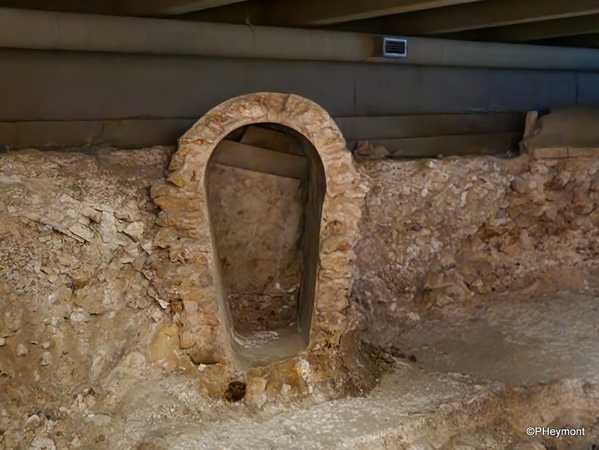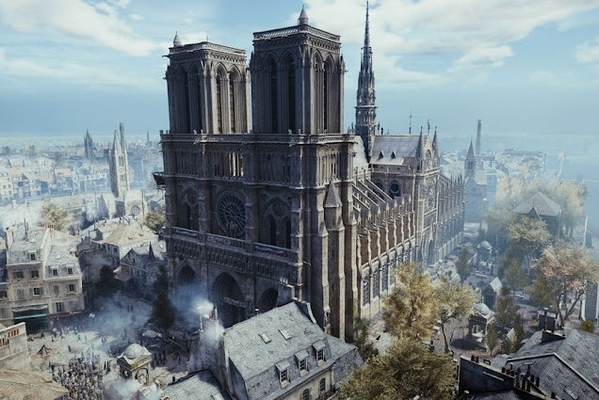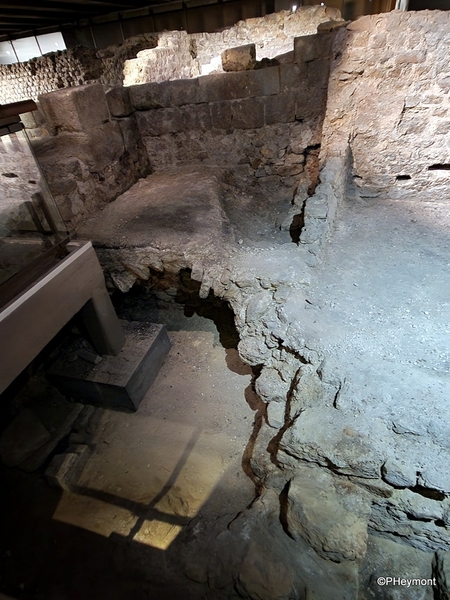The generous plaza that faces the western facade of Notre Dame was not always as open and generous a space. As late as the middle of the 1800s, a variety of buildings stood more-or-less shoulder to shoulder with the cathedral and were only cleared back during Notre Dame's 19th century make-over.
But even before that, the space was busy with buildings, people, shops, baths and more in Roman times, a history that over the last century or so has been recovered in excavations in the forecourt, or parvis of the great church. When the buildings to the right of Notre Dame, photo above, were removed, a large part of a Roman wall was uncovered beneath them.
In the first photo above, a variety of dignitaries, including the mayor, inspect the discovery—which was then covered over to make the strip of parkland along the south side of the cathedral. The next photo shows some of the 1950s excavation in the center of the square that led to the creation of the Archaeological Crypt that is today one of Paris's most fascinating stories.


I had visited the crypt a few years ago; I was fascinated with the idea of an ancient city, metres below the surface and nearly unsuspected. But this time, I took a closer look at the many interpretive signs, and realized that the story of Rome under the forecourt is not what I thought.
While many archaeology exhibits lead us, year by year from founding of a site through its growth and its golden years, the story here is of the Roman Empire in retreat and disarray, shrinking in size, population and wealth.
The immense rampart that marks the southern edge of the crypt is several feet thick and built of large stones, topped with brick and dirt. Much of the stone was not freshly quarried; it came from stripping the Roman arena on the Left Bank that could no longer be defended as local populations became restless and eastern invasions reduced Rome's ability to send troops to defend it.
Inscription on this stone marked the Arena seat of a prominent Roman
Not only the arena, but bathhouses, temples and more were stripped to build the new redoubt on the island in the river. Those who could moved to new tenements and houses and new baths and shops on the island, leaving farmers to hopefully continue to produce crops to feed the city.
New fortified quays were built on the island side of the stream. The importance of the river for supply and transportation is seen in these inscriptions marking their special dedication to Emperor Tiberius. They're from a pillar found below Notre Dame in 1711; they were part of the 4th century wall.
The crypt also shows a fair variety of everyday objects recovered from the excavations, including numbers of pottery, metal and glass eating and storage vessels.
And this set of 'hipposandales,' or horseshoes of rather a different design than those of our times.
Below, a reconstruction of what may have been the process of building the new wall and buildings on the Ile de la Cite,
New plans, announced by Paris Mayor Anne Hidalgo last month, call for more changes in Notre Dame's surroundings as it is rebuilt from the 2019 fire. Among the changes will be new connections between the crypt and the river bank, and possibly further excavation.
And congratulations to George G, who recognized this excavation from among all others as the site of this week's One-Clue Mystery!







Comments (0)